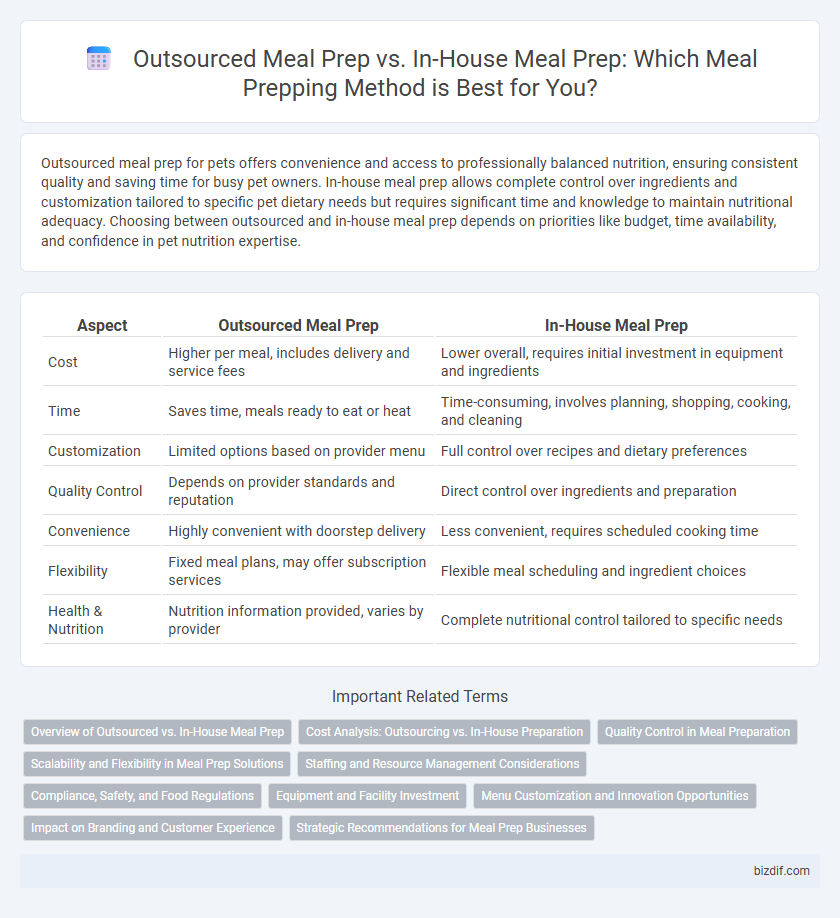Outsourced meal prep for pets offers convenience and access to professionally balanced nutrition, ensuring consistent quality and saving time for busy pet owners. In-house meal prep allows complete control over ingredients and customization tailored to specific pet dietary needs but requires significant time and knowledge to maintain nutritional adequacy. Choosing between outsourced and in-house meal prep depends on priorities like budget, time availability, and confidence in pet nutrition expertise.
Table of Comparison
| Aspect | Outsourced Meal Prep | In-House Meal Prep |
|---|---|---|
| Cost | Higher per meal, includes delivery and service fees | Lower overall, requires initial investment in equipment and ingredients |
| Time | Saves time, meals ready to eat or heat | Time-consuming, involves planning, shopping, cooking, and cleaning |
| Customization | Limited options based on provider menu | Full control over recipes and dietary preferences |
| Quality Control | Depends on provider standards and reputation | Direct control over ingredients and preparation |
| Convenience | Highly convenient with doorstep delivery | Less convenient, requires scheduled cooking time |
| Flexibility | Fixed meal plans, may offer subscription services | Flexible meal scheduling and ingredient choices |
| Health & Nutrition | Nutrition information provided, varies by provider | Complete nutritional control tailored to specific needs |
Overview of Outsourced vs. In-House Meal Prep
Outsourced meal prep involves hiring external services to prepare and deliver meals, offering convenience and time savings for busy individuals or businesses. In-house meal prep requires managing all aspects of food preparation internally, allowing for greater control over ingredients, customization, and quality assurance. Choosing between outsourced and in-house meal prep depends on factors such as budget, scalability, dietary needs, and operational capacity.
Cost Analysis: Outsourcing vs. In-House Preparation
Outsourced meal prep often incurs higher upfront costs due to service fees and packaging, but reduces labor expenses and minimizes food waste through bulk purchasing efficiency. In-house meal prep requires investment in kitchen equipment, ingredient sourcing, and staff time, leading to variable costs influenced by scale and operational expertise. Analyzing cost per meal reveals that outsourcing can be economical for smaller quantities, while in-house preparation offers cost advantages for large-scale or highly customized meal plans.
Quality Control in Meal Preparation
Outsourced meal prep offers standardized quality control through professional kitchens with specialized staff and established protocols, ensuring consistent portion sizes and ingredient standards. In-house meal prep allows for direct oversight and immediate adjustments, providing greater flexibility to tailor meal quality to specific dietary preferences and freshness requirements. Companies prioritizing stringent quality control often weigh the reliability of outsourced consistency against the personalized supervision achievable in-house.
Scalability and Flexibility in Meal Prep Solutions
Outsourced meal prep offers greater scalability by leveraging specialized facilities and professional staff to handle fluctuating volumes efficiently, enabling businesses to expand without significant infrastructure investment. In-house meal prep provides enhanced flexibility, allowing customized menu adjustments and immediate quality control to meet specific dietary needs and preferences. Balancing scalability and flexibility depends on organizational goals, with outsourced solutions favoring rapid growth and in-house setups facilitating tailored culinary innovation.
Staffing and Resource Management Considerations
Outsourced meal prep reduces the need for extensive in-house staffing, allowing businesses to leverage specialized providers with scalable resources and expertise. In-house meal prep requires dedicated staff for ingredient sourcing, preparation, and quality control, increasing labor costs and operational complexity. Effective resource management balances workforce allocation, equipment utilization, and inventory control to optimize productivity and maintain consistent meal quality.
Compliance, Safety, and Food Regulations
Outsourced meal prep services often adhere strictly to food safety regulations and compliance standards due to specialized certification and regular inspections, reducing liability risks. In-house meal prep requires rigorous internal protocols and ongoing staff training to maintain compliance with health codes and prevent contamination. Choosing between outsourced and in-house meal prep hinges on the ability to consistently meet safety standards and regulatory requirements while ensuring quality control.
Equipment and Facility Investment
Outsourced meal prep significantly reduces the need for heavy initial investment in kitchen equipment and facility maintenance, as these costs are absorbed by the service provider. In-house meal prep demands substantial capital expenditure on commercial-grade appliances, refrigeration units, and dedicated prep areas to ensure food safety and efficiency. Choosing outsourced services allows companies to allocate resources away from facility upgrades and equipment purchases, streamlining operational overhead.
Menu Customization and Innovation Opportunities
Outsourced meal prep services offer limited menu customization constrained by standardized meal options, while in-house meal prep allows for tailored recipes that meet specific dietary needs and preferences. In-house meal prep teams can experiment with seasonal ingredients and innovative cooking techniques to continuously enhance menu variety. This flexibility fosters creativity and caters to unique nutritional requirements, driving greater customer satisfaction.
Impact on Branding and Customer Experience
Outsourced meal prep enables brands to leverage specialized culinary expertise and consistent quality, enhancing customer perception through reliable, scalable offerings. In-house meal prep offers greater control over ingredient sourcing and customization, directly influencing brand authenticity and personalized customer experiences. Balancing cost efficiency with brand values determines how meal prep strategies shape customer loyalty and market differentiation.
Strategic Recommendations for Meal Prep Businesses
Meal prep businesses should evaluate cost efficiency, quality control, and scalability when deciding between outsourced and in-house meal prep. Outsourcing offers reduced labor expenses and access to specialized culinary expertise, whereas in-house operations provide tighter quality oversight and brand consistency. Strategic recommendations include conducting thorough vendor assessments for outsourcing and investing in employee training and kitchen technology for in-house preparations to optimize operational performance.
Outsourced Meal Prep vs In-House Meal Prep Infographic

 bizdif.com
bizdif.com